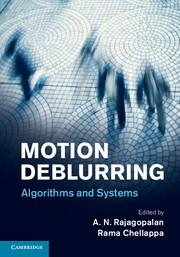Book contents
- Frontmatter
- Contents
- List of contributors
- Preface
- 1 Mathematical models and practical solvers for uniform motion deblurring
- 2 Spatially-varying image deblurring
- 3 Hybrid-imaging for motion deblurring
- 4 Efficient, blind, spatially-variant deblurring for shaken images
- 5 Removing camera shake in smartphones without hardware stabilization
- 6 Multi-sensor fusion for motion deblurring
- 7 Motion deblurring using fluttered shutter
- 8 Richardson–Lucy deblurring for scenes under a projective motion path
- 9 HDR imaging in the presence of motion blur
- 10 Compressive video sensing to tackle motion blur
- 11 Coded exposure motion deblurring for recognition
- 12 Direct recognition of motion-blurred faces
- 13 Performance limits for motion deblurring cameras
- Index
- References
10 - Compressive video sensing to tackle motion blur
Published online by Cambridge University Press: 05 June 2014
- Frontmatter
- Contents
- List of contributors
- Preface
- 1 Mathematical models and practical solvers for uniform motion deblurring
- 2 Spatially-varying image deblurring
- 3 Hybrid-imaging for motion deblurring
- 4 Efficient, blind, spatially-variant deblurring for shaken images
- 5 Removing camera shake in smartphones without hardware stabilization
- 6 Multi-sensor fusion for motion deblurring
- 7 Motion deblurring using fluttered shutter
- 8 Richardson–Lucy deblurring for scenes under a projective motion path
- 9 HDR imaging in the presence of motion blur
- 10 Compressive video sensing to tackle motion blur
- 11 Coded exposure motion deblurring for recognition
- 12 Direct recognition of motion-blurred faces
- 13 Performance limits for motion deblurring cameras
- Index
- References
Summary
Introduction
Spatial resolution of imaging devices is steadily increasing: mobile phone cameras have 5–10MP while point-and-shoot cameras have 12–18MP. As the spatial resolution of imaging devices increases, the effect of either camera or subject motion on the captured images is magnified, resulting in the acquisition of heavily blurred images. Since the motion-blur kernel is a low pass kernel, the high frequencies in the image are heavily attenuated. Deblurring the effects of such low pass blur kernels results in the introduction of significant high frequency artifacts. When the size of the blur kernel is small, these artifacts can be mitigated by the use of appropriate image regularizers that allow for the hallucination of the high frequency detail. Unfortunately there are several scenarios in which such a technique, relying primarily on image regularization, cannot be directly applied. They fall into the following three main categories.
1. Large motion
The resolutions of image sensors are rapidly increasing, while the hands of photographers are not becoming any steadier. This results in ever larger sizes of blur kernels. While image regularization allows us to handle blur kernels of a moderate size (say about 10–15 pixels), larger blur kernels test the ability of even modern deblurring algorithms, especially in regions of high texture. Such large motion blur kernels necessitate active approaches that shape the blur kernel to be invertible in order to handle these robustly.
2. Object motion
Object motion causes blur that is spatially variant. In particular, the blur kernel depends on the local velocity of the objects.
- Type
- Chapter
- Information
- Motion DeblurringAlgorithms and Systems, pp. 207 - 221Publisher: Cambridge University PressPrint publication year: 2014



